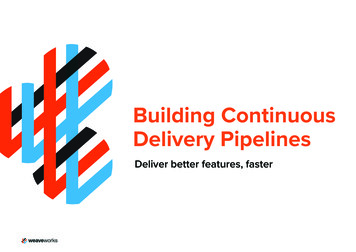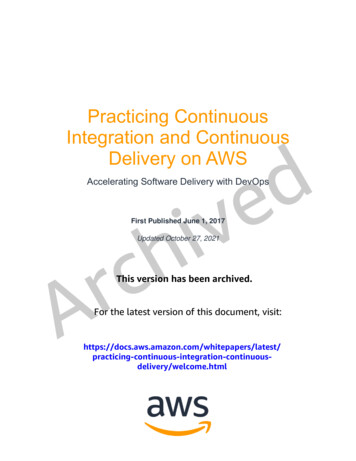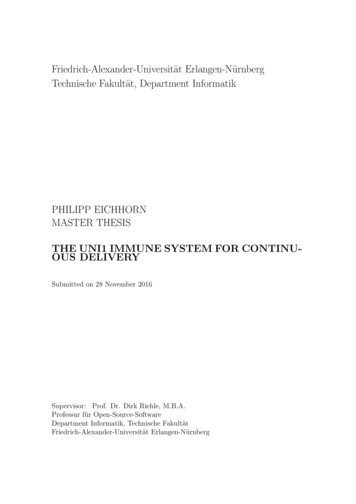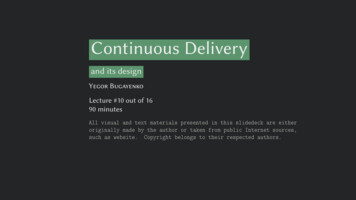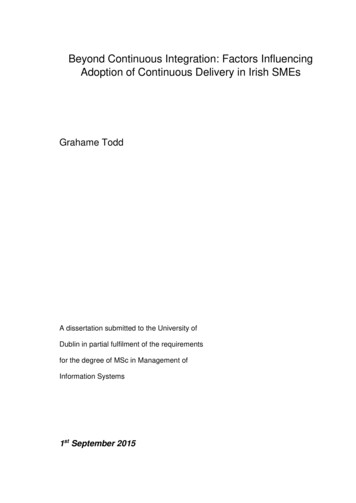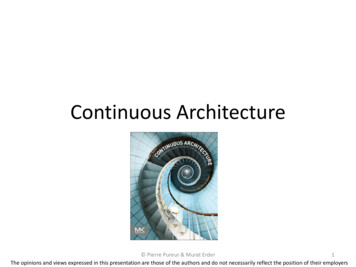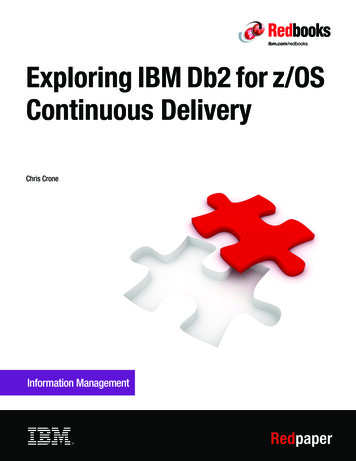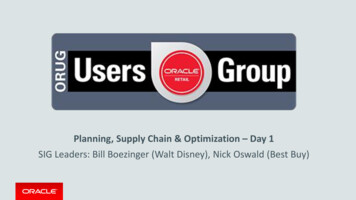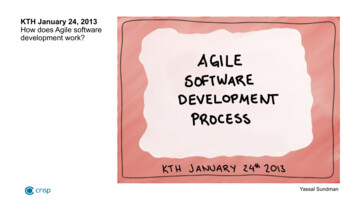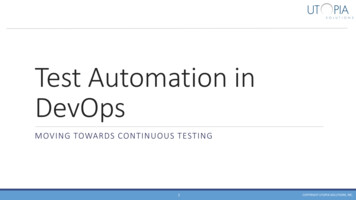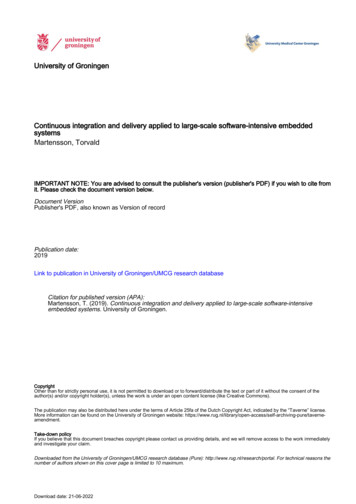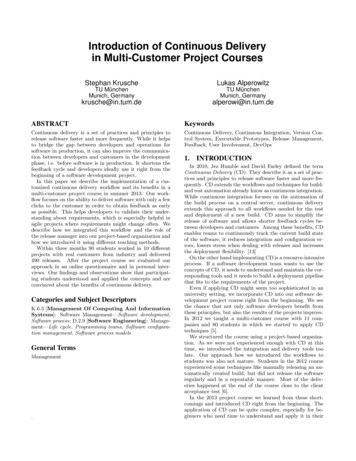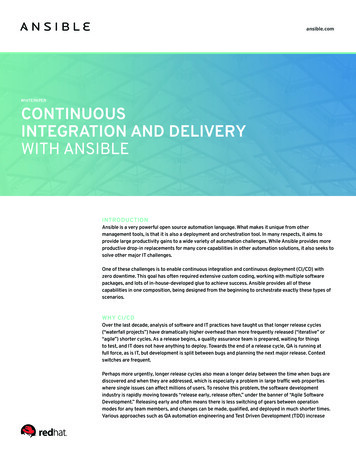
Transcription
ansible.comWHITEPAPERCONTINUOUSINTEGRATION AND DELIVERYWITH ANSIBLEINTRODUCTIONAnsible is a very powerful open source automation language. What makes it unique from othermanagement tools, is that it is also a deployment and orchestration tool. In many respects, it aims toprovide large productivity gains to a wide variety of automation challenges. While Ansible provides moreproductive drop-in replacements for many core capabilities in other automation solutions, it also seeks tosolve other major IT challenges.One of these challenges is to enable continuous integration and continuous deployment (CI/CD) withzero downtime. This goal has often required extensive custom coding, working with multiple softwarepackages, and lots of in-house-developed glue to achieve success. Ansible provides all of thesecapabilities in one composition, being designed from the beginning to orchestrate exactly these types ofscenarios.WHY CI/CDOver the last decade, analysis of software and IT practices have taught us that longer release cycles(“waterfall projects”) have dramatically higher overhead than more frequently released (“iterative” or“agile”) shorter cycles. As a release begins, a quality assurance team is prepared, waiting for thingsto test, and IT does not have anything to deploy. Towards the end of a release cycle, QA is running atfull force, as is IT, but development is split between bugs and planning the next major release. Contextswitches are frequent.Perhaps more urgently, longer release cycles also mean a longer delay between the time when bugs arediscovered and when they are addressed, which is especially a problem in large traffic web propertieswhere single issues can affect millions of users. To resolve this problem, the software developmentindustry is rapidly moving towards “release early, release often,” under the banner of “Agile SoftwareDevelopment.” Releasing early and often means there is less switching of gears between operationmodes for any team members, and changes can be made, qualified, and deployed in much shorter times.Various approaches such as QA automation engineering and Test Driven Development (TDD) increase
WHITEPAPERCI/CD with Ansiblethe effectiveness of these techniques. It stands to reason that if “release early, release often” isprogress, CI/CD may be nirvana. While agility is a progressive spectrum, an organization’s movementin this direction can yield impressive results. To achieve this, automation is key, so there is a hugefocus around the technology that enables quick turnaround, requiring human intervention only whennecessary.In this document, we’ll highlight why Ansible and Red Hat Ansible Tower are the ideal tools toconnect your computer systems to enable these kind of processes.The goal of anyautomation processshould be to enableupdates in a mannerthat does not impactoperational capacity.WHY ZERO DOWNTIME?Downtime and outage windows result in either lost revenue or customer unhappiness. For a majorweb application with users in all time zones around the world, going down for an outage is only tobe reserved for the most dire and complicated of upgrade processes–certainly not updating yourapplication versions. Even for internal applications at large organizations (imagine an accounting orintranet system), an outage in a critical system can mean major impacts on productivity. The goal ofany automation process should be to enable updates in a manner that does not impact operationalcapacity.Zero downtime is achievable, but it requires support from tooling– a strong multi-tier, multi-steporchestration engine like Ansible– to make it manageable.OTHER BUILD SYSTEMSBefore Continuous Delivery (CD) can be achieved, the first step is to achieve Continuous Integration(CI). Simply put, CI systems are build systems that watch various source control repositories forchanges, run any applicable tests, and automatically build (and ideally test) the latest version of theapplication from each source control change, such as Jenkins (jenkins.io).The key handoff for CD is that the build system can invoke Ansible upon a successful build. Userswho also run unit or integration tests on code as a result of the build will also be one step ahead ofthe game. Jenkins can utilize Ansible Tower to deploy the built artifact into multiple environments,but a QA/stage environment modeled after production ups the ante and substantially improvespredictability along the lifecycle. The data provided back by Ansible can then be referenced, anddirectly correlated to an Ansible Tower job in the Build Systems job.In fact, as we’ll detail later, we can use Ansible Tower against a stage environment to do testing priorto a production deployment.2
WHITEPAPERCI/CD with AnsibleAnsible’s uniquemulti-tier, multi-steporchestrationcapabilities, combinedwith its push-basedarchitecture, allowfor extremely rapidexecution ofthese types ofcomplex workflows.ROLLING UPDATES AND MULTI-TIER APPLICATIONSThe absolute requirement in a CD system is the ability to orchestrate rolling updates among variousarchitecture tiers in an application. Ansible’s unique multi-tier, multi-step orchestration capabilities,combined with its push-based architecture, allow for extremely rapid execution of these types ofcomplex workflows. As soon as one tier is updated, the next can begin, easily sharing data betweentiers.One of the core features of Ansible that enables this is the ability to define “plays,” which select aparticular fine-grained group of hosts and assign some tasks (or “roles”) for them to execute. Tasksare typically declarations that a particular resource be in a particular state, such that a packagebe installed at a specific version or that a source control repository be checked out at a particularversion.In most web application topologies, it is necessary to update particular tiers in a tight sequence. Forinstance, the database schema may need to be migrated and the caching servers flushed prior toupdating the application servers.More importantly, it is vital to not be managing the applications and configuration of the system for allsystems in production at the same time.When services restart, they may not be immediately available. Replacing an application version mayalso not be instantaneous. It is important to be able to take machines out of a load balanced pool priorto update. It is also then critical to be able to automate the actions of taking machines in and out ofthe pool.Ansible allows you to control of the size of a rolling update window through the ‘serial’ keyword.Additionally, Ansible’s rolling update handling is smart enough so that if a batch fails, the rollingupdate will stop, leaving the rest of your infrastructure online.CONTINUOUS DEPLOYMENT OF MANAGEMENT CONTENTIn addition to CD of production services, it’s also possible to continuously deploy Ansible Playbookcontent itself. This allows systems administrators and developers to commit their Ansible Playbookcode to a central repository, run some tests against a stage environment, and automatically applythose configurations to production upon passing stage. This allows the same software processused for deploying software to be applied to configuration management, reaping many of the samebenefits.As software or configuration change is a significant cause of unintended outage, both automatedtesting and human review can be useful measures to implement. This can be coupled with a codereview system, like Gerrit (gerritcodereview.com), to require sign off from multiple users beforechanges are applied.3
WHITEPAPERCI/CD with AnsibleROLLING UPDATES AS APPLIED TO LOAD BALANCING & MONITORINGAnsible is adept at working with tools such as load balancers in the course of executing a rollingupdate. In the middle of any Playbook “host loop,” it is possible to say “do this action on system X onbehalf of host Y.”This includes both communicating with load balancers of all kinds, as well as flagging outage windowsfor particular hosts to disable monitoring alerts for the hosts currently being updated. Simple idiomslike “disable monitoring - remove from pool - update tier - add to pool - enable monitoring” allow forupdates without downtime or false alarm pager alerts that work in an automated manner every timewithout manual intervention.INTEGRATED STAGE TESTING WITH ANSIBLEUsing Ansible Tower with multiple inventory sources allows for testing an Ansible Playbook with astage environment and requiring successful execution of an update prior to rollout into production.This setup, while optional, is ideal for modeling production update scenarios (perhaps at a smallerscale) prior to updating systems in the real world. Just use the “-i” parameter to an Ansible Playbookto specify what inventory source the Playbook should run against, and use the same Playbook forboth stage and production.VERSION CONTROL BASED DEPLOYMENTVarious organizations like to package their applications with OS packages (RPM, debs, etc.) but inmany cases, particularly for dynamic web applications, such packaging is unnecessary. For this reasonAnsible contains numerous modules for deploying straight from version control. A Playbook canrequest that a repository be checked out at a specific tag or version, and then the system will makesure this is true across the various servers. Ansible can report change events to trigger additionalfollow up actions when the version of software needed to change, so that associated services are notrestarted unnecessarily.INTEGRATIONS WITH MONITORING TOOLSBecause Ansible is an orchestration system, integrations can be made with APM monitoring tools aswell. For instance, let’s assume that during an integration test or deployment, an APM system has anagent that needs to be installed/updated on the application. Ansible can have a Role that handles theinstall of the agent against the application stack. Once the agent is online, Ansible can then set alertsup (if they don’t already exist) in the monitoring stack. This monitoring can then provide immediatedata back to teams interested in the deployment; letting them know if the application is runningwithout issue.If something were to occur with the application in production after the upgrade, Ansible could beinvoked by the monitoring tool to revert to a previous known good build of the application. Obviouslythis can be done if, and only if, the application will allow for the reverted build.4
WHITEPAPERCI/CD with AnsibleCALLBACKS AND PLUGGABILITYWhen in a culture of CI/CD, it can often be useful to provide alerts when events occur. Ansible includesseveral facilities to do this, including an integrated mail module. Additionally, a callback facility allowsfor plugging in notifications with arbitrary systems, which can include chat broadcasts (IRC, Campfire,etc), custom logging, or internal social media.THE DESIRED STATE RESOURCE MODEL AS APPLIED TO DEPLOYMENTOne of the key features that makes Ansible interesting for software deployment is the use of statebased resource model, made popular in configuration management tooling, within the process ofupdating software. While traditionally some open source tooling has had to be supplemented withadditional deployment software and scripts, this is not the case for Ansible.This is made possible by the ability for Ansible to finely control the order of events between differenttiers of systems, to delegate actions to other systems, and also to mix resource model directives (“thestate of package X should be Y”) versus traditional command patterns (“run script.sh”) in the sameprocess.By unifyingconfiguration anddeployment underone toolchain,it is possible toreduce overheadof managingdifferent tooling,and also achievebetter unificationbetween OS andapplication policy.Ansible also allows easily executing commands to test for various conditions, and then makeconditional decisions based on the results of those commands. By unifying configuration anddeployment under one toolchain, it is possible to reduce overhead of managing different tooling, andalso achieve better unification between OS and application policy.EMBEDDED TESTS INTO DEPLOYMENTWith great power comes great responsibility. One of the dangers of setting up an automated CDsystem is the chance for an bad configuration to be propagated to all of one’s systems. To help protectagainst this, Ansible allows for adding tests directly in Playbooks that can abort a rolling updateif something goes wrong. Arbitrary tests, deployed with the ‘command’ or ‘script’ module, or evenwritten as native Ansible modules, can be deployed to check for various conditions. This may includethe functioning state of the service.At any point, usage of the ‘fail’ module can abort execution for the host. Thus, it’s easy to catch errorsearly on in a rolling update window. For instance, suppose a difference between stage and productionresulted in a configuration error that would only break a production deployment. In this case, AnsiblePlaybooks can be written to stop the update process in the first stage of the rolling update window.If there were 100 servers and the update window was 10, the update window would stop and allowintervention. Once corrected, simply re-run the Playbook to continue the update.In the event of a failure, Ansible does not keep going and half-configure the system. It raises the errorto your attention so it can be managed, and produces summaries of what hosts in the update cyclehad problems and how many changes were executed on each platform.5
WHITEPAPERCI/CD with AnsibleCOMPLIANCE TESTINGIn many environments, a configuration change should not be applied unless some change is actuallyneeded. It should be first understood and agreed upon by a human prior to “pushing the button.” Inthese cases, a CD system can still be leveraged with some caveats.Ansible contains adry-run mode via a“--check” flag thatwill report on whatchanges would havebeen made by runninga Playbook process.In this case, Ansible contains a dry-run mode via a “--check” flag that will report on what changeswould have been made by running a Playbook process. As this will skip the actual commandexecutions and not account for possibly failing scripts, this is just a guideline, but it is a very usefulguideline and a useful tool to have in one’s toolkit.Even if deploying continuously when new build products are available, it is possible to run compliancechecks even more frequently, to report on when things in production might have changed due tohuman invention and need to be corrected by another Playbook run. This can be an easy way to detectthat a software change may need to occur, a permission may need to be corrected, and so on.PUTTING DEPLOYMENT ON AUTOPILOTAnsible contains numerous tools and features to make it an ideal CI/CD solution. These includethe ability to finely orchestrate multi-tier, multi-step processes in zero-downtime rolling updateworkflows. This is made possible by Ansible’s unique architecture, and coupled with the agentlesssystem (which adds security and no need to manage the management), it is easy to establish simplehuman-readable representations of what were previously complex manual IT processes. The days oflocking an ops team in a conference room to perform a mix of manual and automated steps are gone.Ansible puts deployment on full autopilot.“Full autopilot” of course means enabling the true promise of agile processes: delivering changefaster, with fewer errors, and with fewer expensive context shifts. Eliminating outage windows, andespecially manual change errors, is something that is expressly critical for any core internal IT serviceor high-traffic web property.Through architectural features in Ansible, and the ability to tightly integrate with CI systems likeJenkins, not only can configuration be automated, but all aspects of IT processes can be automated.This is why we refer to Ansible as an orchestration engine, as opposed to filing it under justconfiguration management or software deployment.EXAMPLES AND FURTHER INFORMATIONSome basic examples of Ansible content can be found at:github.com/ansible/ansible-examplesTry Ansible Tower now:ansible.com/tower6
ABOUT RED HAT ANSIBLE TOWERAnsible, an open source community project sponsored by Red Hat, is the simplest way toautomate IT. Ansible is the only automation language that can be used across entire IT teams– from systems and network administrators to developers and managers. Red Hat Ansible Automation provides enterprise-ready solutions to automate your entire application lifecycle –from servers to clouds to containers and everything in between. Red Hat Ansible Tower is acommercial offering that helps teams manage complex multi-tier deployments by adding control,knowledge, and delegation to Ansible-powered environments.ABOUT RED HATRed Hat is the world’s leading provider of open source software solutions, using a communitypowered approach to provide reliable and high-performing cloud, Linux, middleware, storage, andvirtualization technologies. Red Hat also offers award-winning support, training, and consultingservices. As a connective hub in a global network of enterprises, partners, and open sourcecommunities, Red Hat helps create relevant, innovative technologies that liberate resources forgrowth and prepare customers for the future of IT.NORTH AMERICA1 888 REDHAT1www.redhat.comEUROPE, MIDDLE EAST,AND AFRICAASIA PACIFICLATIN AMERICA00800 7334 2835 65 6490 4200 54 11 4329 hat.comCopyright 2017 Red Hat, Inc. Red Hat, the Shadowman logo, and Ansible are trademarksor registered trademarks of Red Hat, Inc. or its subsidiaries in the United States and other countries.
Ansible is a very powerful open source automation language. What makes it unique from other . This goal has often required extensive custom coding, working with multiple software packages, and lots of in-house-developed glue to achieve success. Ansible provides all of these . intranet system), an outage in a critical system can mean major .
